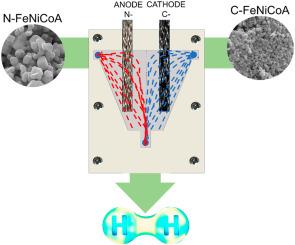Hydrogen production via ammonia using trimetallic-doped aerogels based on Fe, Ni, Co
IF 7.9
2区 工程技术
Q1 CHEMISTRY, PHYSICAL
引用次数: 0
Abstract
This article explores the electrocatalytic response of novel iron-nickel-cobalt unsupported doped aerogels (FeNiCoA) in a microfluidic electrochemical ammonia device for hydrogen production and electrolyser cell operation. These aerogels were synthesised by the ultrafast sol-gel method assisted by microwave heating, resulting in homogeneous morphological structures. Different stoichiometries of the aerogel: raw FeNiCoA, reduced rFeNiCoA, and heteroatom-doped FeNiCoA were used as electrocatalysts for the ammonia oxidation reaction (AOR) and to produce clean hydrogen. The incorporation of carbon (C-FeNiCoA) and nitrogen (N-FeNiCoA) into the aerogel matrix played a crucial and innovative role in improving the electrocatalytic activity and promoting electron transfer. The microfluidic device using these novel aerogels exhibits high power and current densities, demonstrating its potential for high hydrogen generation (3 10−8 mol of hydrogen in 20 s). This study shows that transition metal aerogels are a cost-effective alternative to noble metals as electrocatalysts for hydrogen production.

基于Fe, Ni, Co的三金属掺杂气凝胶的氨制氢研究
本文研究了新型铁镍钴无负载掺杂气凝胶(FeNiCoA)在用于制氢和电解槽操作的微流控电化学氨装置中的电催化反应。这些气凝胶采用微波加热辅助的超快溶胶-凝胶法合成,具有均匀的形态结构。用不同化学计量的气凝胶:原FeNiCoA、还原的rFeNiCoA和杂原子掺杂的FeNiCoA作为氨氧化反应(AOR)的电催化剂,产生清洁的氢气。将碳(C-FeNiCoA)和氮(N-FeNiCoA)加入气凝胶基质中,在提高电催化活性和促进电子转移方面发挥了至关重要的创新作用。使用这些新型气凝胶的微流控装置具有高功率和高电流密度,表明其具有高氢气生成潜力(20秒内3·10−8 mol氢)。该研究表明,过渡金属气凝胶是一种具有成本效益的替代贵金属的制氢电催化剂。
本文章由计算机程序翻译,如有差异,请以英文原文为准。
求助全文
约1分钟内获得全文
求助全文
来源期刊

Journal of Power Sources
工程技术-电化学
CiteScore
16.40
自引率
6.50%
发文量
1249
审稿时长
36 days
期刊介绍:
The Journal of Power Sources is a publication catering to researchers and technologists interested in various aspects of the science, technology, and applications of electrochemical power sources. It covers original research and reviews on primary and secondary batteries, fuel cells, supercapacitors, and photo-electrochemical cells.
Topics considered include the research, development and applications of nanomaterials and novel componentry for these devices. Examples of applications of these electrochemical power sources include:
• Portable electronics
• Electric and Hybrid Electric Vehicles
• Uninterruptible Power Supply (UPS) systems
• Storage of renewable energy
• Satellites and deep space probes
• Boats and ships, drones and aircrafts
• Wearable energy storage systems
 求助内容:
求助内容: 应助结果提醒方式:
应助结果提醒方式:


